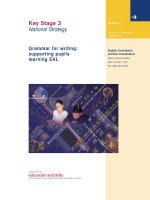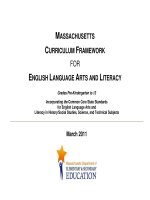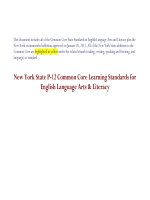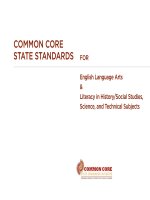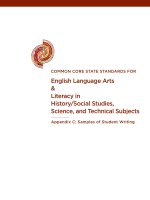Collaborating-for-Change-Expanding-Arts-Learning-in-Chicago
Bạn đang xem bản rút gọn của tài liệu. Xem và tải ngay bản đầy đủ của tài liệu tại đây (867.48 KB, 21 trang )
CHICAGO ARTS LEARNING INITIATIVE
Collaborating for Change:
Expanding Arts Learning in Chicago
This report was made possible by generous support from:
JPMorgan Chase & Co.
The Chicago Community Trust
Lloyd A. Fry Foundation
And the dedication of more than 250 community leaders
June 2010
Chicago Arts Learning Initiative Chicago, IL www.ChicagoArtsLearning.org
Chicago Arts Learning Initiative
Arts Education for Chicago’s Children
Parents, educators, community leaders, and elected officials all want to make sure that Chicago!s
children get the education needed to lead meaningful, productive lives. But “reading, writing,
!rithmatic” – the 19th century formula to prepare students for industrial jobs – is no longer enough.
Schools need to foster creativity, critical thinking, problem solving, collaboration, and communications – skills essential to participating in our democracy and succeeding in the emerging global
economy.
The arts arm students with these essential skills. Th arts encourage and give expression to students! creativity, desire to communicate, and appreciation for beauty. Producing works of art,
from third-graders! self-portraits to the high school play, demands problem solving, critical thinking, discipline, and collaboration. Because they access multiple human intelligences and engage
a variety of learning styles, the arts support and enhance education for all students. They enrich
the school environment, foster appreciation for different cultures, and add a whole new dimension to students! lives.
But instead of expanding arts to develop students! full potential, since the 1970!s schools have
gone in the opposite direction. Facing budget cuts and shorter school days, districts throughout
the nation have reduced support for arts education. The trend accelerated in 2002, when the federal government!s No Child Left Behind policy began emphasizing accountability of schools for
achievement in math, science and reading. As a result, schools concentrated on areas of learning for which they were held accountable and other subjects received less attention, thus narrowing the curriculum and the learning experiences of students.
Collaborating for Change: Expanding Arts Learning in Chicago!
1
Chicago Arts Learning Initiative
In Illinois, the school code specifies that every school provide adequate instruction in the arts to
all students. Chicago Public Schools set minimal levels: in order to graduate students must take
two credits in the fine arts, which they define as music and “art or drafting”. But we do not have
accurate information about how these minimal requirements are implemented in schools. Chicago schools for
many decades have had local decision-making power in
terms of curriculum and instruction . As a result, actual
arts instruction across schools and its impact on students’ learning are not known at a system level. Without
solid evidence about the actual amount of arts education
“We are educating people out of
their creative capacities. Picasso
once said that all children are born
artists. The trick is to remain an
artist as we grow up. I believe this
passionately: We don't grow into
creativity; we grow out of it. Or,
rather, we get educated out of it.
students in Chicago are receiving, it has been difficult to
Creativity now is as important in
education as literacy, and we
report how arts education affects academic achievement
should treat it with the same
or supports school success.
status.”
Sir Ken Robinson, TED conference,
2006
What we do know suggests that few Chicago students
receive a comprehensive arts education that is both discipline-specific and integrated into their
broader educational experiences. Only in schools where the value of the arts is clearly understood, and where infrastructure, resources, and relationships between educators and the arts
community are strong, do Chicago students receive a comprehensive education in the arts. Everyone else is left behind.
To give our students the best chance of developing the skills to succeed in the global economy
and lead rich, productive lives, we must expand arts learning opportunities for all Chicago Public
School students. Over the last year, Chicago arts groups, educators, civic and philanthropic
leaders have been meeting through the Chicago Arts Learning Initiative to lay a roadmap for doing that. This report presents their recommendations. We invite parents, educators, community
and corporate leaders, and public officials to begin working with us to make that happen.
Collaborating for Change: Expanding Arts Learning in Chicago!
2
Chicago Arts Learning Initiative
How We Got Here
In its 2001 survey Arts Education in the Chicago Public Schools, The Chicago Community Trust
found that Chicago schools offered widely different levels of arts education. Some schools had
no arts instruction, while others offered two or more hours a week; the average was 45 minutes
of art or music instruction per week. Eighty-six percent of elementary schools taught only one
art discipline; only 6 percent included anything beyond visual arts and music. One third of elementary schools offered no performance opportunities – no chorus, band, drama, or dance.
As a result of this research, a group of funders and civic agencies joined together to explore how
to build sustainable access to sequential arts instruction for all students. This collaborative, now
known as the Chicago Arts Education Collaborative, helped establish and fund the Chicago
Public School Office of Arts Education, an important step toward securing system-wide commitment to arts as a core area of learning. They also supported the creation of Illinois Creates, a
state advocacy agenda run by Arts Alliance Illinois. These efforts created an important base of
knowledge and helped establish a stronger arts education infrastructure in Chicago.
We found little collaborative effort
By 2008, however, it became clear that the effort to expand
arts education still lacked several critical elements:
•
•
a coordinated effort to build the capacity of arts
school district’s newly hired
[Director, Office of Arts Education].
educators and schools
The city’s many other networks of
reliable benchmarks and accurate data on the avail-
providers and influencers were
involved in their own efforts, but
ability of arts education
•
[in Chicago] other than that of a
group of foundations supporting the
an organized local advocacy effort
To take up this challenge, in 2009 the Collaborative
launched the Chicago Arts Learning Initiative also known
there was little coordination across
them.”
RAND Corporation, Revitalizing Arts
Education through Community-Wide
Coordination, 2008.
as CALI. CALI is a community-wide effort bringing together large and small arts and cultural organizations, Chicago schools, the district’s Office of
Arts Education, and funding organizations. Its goal is to leverage existing assets, including Chicago’s strong community of cultural institutions and the work of hundreds of dedicated arts
Collaborating for Change: Expanding Arts Learning in Chicago!
3
Chicago Arts Learning Initiative
teachers, to ensure equitable and sustainable access to innovative arts learning for all Chicago
Public School students.
CALI began by taking stock: it surveyed the arts education community, convened over 200 individuals through four community forums, and held a daylong retreat of sixty arts and education
leaders. Through these efforts, Chicago’s arts education community identified opportunities and
gaps that can be addressed through increased collaboration and coordination, thus making it
possible to improve and expand the delivery of arts education in Chicago.
In June 2009, CALI formed workgroups of teachers, principals, parents, artists, funders, and
representatives from higher education and cultural organizations to create action plans. The
groups developed recommendations on how to identify and fill information gaps, create a
stronger network of arts educators, and build the capacity of schools and school leaders. They
were able to leverage the Chicago Public School Office of Arts Education’s Chicago Guide for
Teaching and Learning in the Arts, which was still under development but offered a standardsbased, developmental framework for teaching and learning in the arts and a platform for greater
coherence and quality in arts education for students.
Finally, the groups were able to articulated a set of shared values and goals for arts education in
Chicago, and established a set of desired outcomes for CALI:
•
Increasing information and understanding about the levels and availability of arts education in Chicago Public Schools
•
Creating a strong, evidence-based case and a unified message about the importance of
investing in arts learning
•
Establishing effective arts leadership within schools and communities, particularly in areas where students receive little or no arts instruction
•
Identifying, understanding and leveraging models and best practices to promote more
effective, innovative arts instruction by well-prepared and empowered educators
•
Pursuing equitable distribution of arts resources and services in schools across the city
Collaborating for Change: Expanding Arts Learning in Chicago!
4
Chicago Arts Learning Initiative
CALI Action Plan
Our Shared Vision for Chicago Public School Students
From the day they start school until the day they graduate, all Chicago Public School students will have access to innovative and engaging arts education both in and out of the
classroom. This education will provide opportunities for our youth to develop as innovative
thinkers and creative problem solvers who are capable of expressing themselves, understanding others and contributing to the culture of their time.
Chicago
chools
Public S
Arts P
artner
s
Collaborating for Change: Expanding Arts Learning in Chicago!
5
Chicago Arts Learning Initiative
What We Believe
The following core values guide our individual and collective efforts to expand access to and improve the delivery of arts learning in Chicago:
INSTRUCTION
• Arts teaching and learning should be standards based, developmentally appropriate, and
built on a scope and sequence as suggested in The Chicago Guide for Teaching and Learn-
•
•
•
•
ing in the Arts. It should be deeply engaging and relevant to students and school communities.
Arts should provide students and classroom teachers with opportunities to deepen learning
in other subjects through an interdisciplinary approach and project-based, hands-on experiences.
Arts instruction in every school should embrace the cultural diversity of the city and its
neighborhoods.
All students and teachers should have access to Chicago’s multifaceted and vibrant cultural
arts community.
Arts learning opportunities should be available during the school day, before or after school,
and during the summer at schools and other sites.
EDUCATORS
• Dynamic and committed principals should serve as leaders in their schools for developing,
sustaining and heralding the arts.
•
In every school, credentialed arts teachers are essential to providing depth and breadth of
instruction in the arts as part of the core curriculum
•
In collaboration with credentialed arts and classroom teachers, arts partners and teaching
artists should strengthen and expand arts learning in and outside the classroom.
COMMUNITY
•
Students, educators and parents, through their participation in and through the arts, should
build engaging classrooms and school communities that serve the needs of diverse learners.
•
Active community participation and collaboration are needed to support, enrich and expand
arts learning for students.
ADVOCACY
•
Building public will for comprehensive arts education should be the collective responsibility
of our schools, communities, elected officials, and arts sector.
MEASUREMENT AND ACCOUNTABILITY
• Meaningful arts education data should be reported, collected, analyzed and shared.
•
All arts programs should have specific benchmarks that measure achievement at both the
student and school levels.
Collaborating for Change: Expanding Arts Learning in Chicago!
6
Chicago Arts Learning Initiative
Recommendations for Change
Drawing on the workgroup recommendations, the CALI advisory group has developed the
following Action Plan. The plan identifies five priorities for expanding arts education, and
calls for a renewed public commitment and dedicated collaboration among educators,
teachers, artists and arts groups, funders and public officials to achieve these goals.
Knowledge
!
!
!
PRIORITY 1: CREATE ACTIONABLE KNOWLEDGE
To improve arts education in Chicago, we must start with a clear picture of what
currently exists, respond to gaps or inequities, and then track the results as we go forward. We
need reliable data to prioritize the distribution of resources and services, identify opportunities,
make the case to key decision makers for equitable access to arts education, and document
the results. Our goal is to make reliable data widely available about the
status and quality of arts education in Chicago Public Schools (CPS).
We will pursue the following strategies in support of this goal:
Action 1: Analyze data that currently exist within CPS and create a reporting
mechanism to track progress. Working with CPS, baseline data will be analyzed to
determine current arts education programming supported by the district. To further
transparency, a reporting mechanism will be created using key performance measures.
School-based results will be posted online to create benchmarks, plan appropriate technical assistance, and track progress.
Actions 2: Create an online tool to market the services of arts providers and
track their programs in schools. The Arts Alliance Illinois is launching a robust, new
online Arts Education Provider Directory. This online tool will help match schools with arts
partners, provide data about where and how arts partners are serving schools, and iden-
Collaborating for Change: Expanding Arts Learning in Chicago!
7
Chicago Arts Learning Initiative
tify gaps and opportunities for programs and professional development to serve specific
needs.
Action 3: Create an online map on the availability of arts education in CPS. Utilizing the data from CPS and the Arts Alliance directory, map arts education throughout the
district, correlate the information with school performance data, and identify patterns and
trends. Populated annually with up-to date information, this map will be an incredibly
useful resource to identify schools that could benefit from expanding arts learning.
Action 4: Develop a research agenda. Research has presented compelling evidence
linking student learning in the arts to various academic and social benefits. Making the
case for increased investment in arts in every school requires further evidence demonstrating the impact of rigorous in-school and out-of-school arts programs on students,
schools and communities. A citywide taskforce will be assembled to develop a Chicagobased arts education research agenda that would include documenting measures of
quality and identifying best practices in instruction, assessment and evaluation.
Action 5: Create an online knowledge center. To make it easier for people to find information, we need a centralized source for and about Chicago’s arts education sector.
We will create a resource and communication hub that includes information and research, instructional tools, directories of people and organizations, and online conversations to help schools and arts education providers enhance the delivery of arts education. This will be a place to share successes, challenges, and best practices. It will also
be a platform for discussion in which arts educators will be invited to post information,
write articles and engage in online dialogue.
!
!
!
!
!
!
!
Collaborating for Change: Expanding Arts Learning in Chicago!
8
Chicago Arts Learning Initiative
! Advocacy
!
PRIORITY 2: INCREASE DEMAND FOR ARTS EDUCATION
!
In a time of scarce resources and fierce accountability pressures, we need to
affirm the value of arts education and make the case for extending it to all children as a fundamental part of their education. To do this, we need to build demand for arts education supported by a compelling argument and effective advocates who speak out in support of expanded arts learning. Our goal is to have a coordinated advocacy effort that
advances arts education in CPS.
We will pursue the following actions in support of this goal:
Action 1: Make the case for arts education for all CPS students. An advocacy task
force will be formed to develop a compelling case and advocacy strategy for arts education using new and existing research, testimony from students, and examples from Chicago’s arts community. The task force will:
•
Lay out a policy agenda for arts education in Chicago that supports high quality
education for all CPS students and seek broad endorsement from the arts and
education communities, parents, elected officials and civic leaders for those policies. Policy priorities might include school compliance with the current CPS-CTU
contract that provides allocations for credentialed arts teachers at 0.5 or 1.0 FTE
levels according to school size or maintaining the CPS Office of Arts Education
and the Office of Academic Enhancement’s Fine and Performing Arts Magnet and
Magnet Cluster Program Schools.
•
Launch a campaign to educate and engage parents and education decisionmakers. A targeted awareness building and advocacy campaign will be launched
to influence the Chicago Board of Education, chief area officers and principals to
expand resources for arts education. The campaign will also help build awareness
and demand among parents, so that they will seek out arts education in selecting
schools for their children and advocate for arts education in schools their children
already attend.
Collaborating for Change: Expanding Arts Learning in Chicago!
9
Chicago Arts Learning Initiative
Leadership
!
!
!
PRIORITY 3: BUILD AND SUPPORT SCHOOL LEADERSHIP
Comprehensive arts education is most likely to happen in schools where its
value is clearly understood, and where infrastructure, resources, and relationships between the
district, schools, arts educators, and arts providers are aligned. To encourage all schools to truly
commit to arts education, we seek to encourage and support dynamic and knowledgeable
leadership by chief area officers and principals, who play a pivotal role in allocating resources for
arts education. We also hope to support and train teachers, who often lead collaborative efforts
among their peers, parents and external arts partners. Our goal is to have effective
and committed arts leadership in every CPS school.
We will pursue the following actions in support of this goal:
Action 1: Develop an Education Leaders Institute for school leaders. In partnership with the district and arts organizations, the institute will provide coordinated training
and support for chief area officers, principals, and other school leaders. The Institute will
show participants:
•
How to embed the arts in school-level planning, including how to incorporate the
arts into the School Improvement Plan for Advancing Academic Achievement (SIPAAA)
•
What students should be able to know and do, based on The Chicago Guide for
Teaching and Learning in the Arts
•
How and why to establish a school-based arts instructional leadership team that
can help make decisions about the arts program and coordinate professional development
•
How to identify and incorporate arts partners into their strategy for delivering arts
instruction
•
What resources are available to help them bring arts education to all of their students
Collaborating for Change: Expanding Arts Learning in Chicago!
10
Chicago Arts Learning Initiative
Action 2: Publish the Five Fundamentals of Arts Learning, a framework for
school-level planning in the arts. Successful schools focus their improvement efforts
on a few key areas. The Five Fundamentals of Arts Learning, based on the CPS Five
Fundamentals for School Success model, give guidance for Instruction, Instructional
Leadership, Professional Capacity, Learning Climate, and Family & Community Involvement. The Fundamentals should be incorporated into the Education Leaders Institute
and broadly distributed to help CPS practitioners and stakeholders focus on what matters most in developing arts programs.
Action 3: Document models of best practice in CPS. District leaders, principals,
teachers and members of the arts community all want to know about successful models
of arts education delivery, but few models are documented and shared. In an effort to
demonstrate how arts education is already effectively implemented in many schools, best
practice models will be identified and shared.
Quality
!
PRIORITY 4: IMPROVE THE QUALITY OF TEACHING AND LEARNING
In order to enhance learning we must ensure arts educators have the tools to
succeed including information, training and support. Building on the platform CALI has already
established, new opportunities must be developed to bring certified arts educators, arts partners, teaching artists and others together to develop mutual understanding and trust, refine their
practice, support their commitment, and inspire new ways of meeting the needs of students.
Our goal is to have an organized learning community for arts educators
supported with professional development opportunities to improve the
quality of teaching and learning.
Collaborating for Change: Expanding Arts Learning in Chicago!
11
Chicago Arts Learning Initiative
We will pursue the following actions in support of this goal:
Action 1: Create an arts education professional development consortium. Formed
with diverse representation from arts educator groups, the consortium will design and
support the coordination of citywide learning communities and professional development
that is cohesive, consistent, challenging and relevant. Arts educators will be empowered to
define professional needs and develop strategies to improve curriculum, teaching methods, and the school environment. The professional development consortium will:
•
Track, develop and publicize professional development programs. Information will
be shared online and include a calendar of arts education professional development
and networking opportunities linked to the online knowledge center (see Priority 1,
Action 5).
• Create learning communities focused on inquiry and improvement. A professional
network will bring together certified arts educators, classroom teachers, teaching
artists and directors of arts education programs who wish to enhance their practice
and improve student outcomes. Through learning communities, novice and experienced arts educators can take advantage of opportunities for professional growth,
be inspired by their peers, and become more effective teachers and school reformers.
Action 2: Develop a program to advance the practice of teaching artists. Drawing
on the leadership, expertise and resources of Chicago arts community, we propose to advance the practice of teaching artists through a program or set of programs that provides
mentoring, peer-to-peer training, and possibly a certification or endorsement. These training opportunities will be rooted in both educational philosophy and artistic practice; and
will target practicing artists interested in building their capacity to provide rigorous and effective arts instruction in the classroom.
Collaborating for Change: Expanding Arts Learning in Chicago!
12
Chicago Arts Learning Initiative
Coordination PRIORITY 5: COORDINATE, ALIGN AND SUSTAIN
!
No one organization or individual will be able to bring about systemic change
to expand access and ensure the sustainability of arts education for all Chicago children; that
requires sustained commitment and collaboration by many people working to build public understanding, improve policies, and increase the capacity and coordination of the entire arts
education field. In particular, we need greater coordination and alignment around advocacy, information management, professional development and resource distribution. Our goal is to
have an aligned and supported arts education system to maximize opportunities for students.
We will pursue the following actions in support of this goal:
Action 1: Develop an appropriate structure to support and coordinate the CALI
recommendations and actions. A taskforce will be assembled to recommend an appropriate structure to support the work of CALI and build adaptive capacity for the arts
education sector. The taskforce will consider other models and develop recommendations on an organizational structure, startup plan, staffing, leadership structure, budget
and long-range planning to sustain the effort. Community input will be collected and incorporated before the recommendations are finalized.
Action 2: Improve the distribution of arts education resources. Much like afterschool programs, arts education programs provided by external arts partners are spread
unevenly across the city, and there is no effective mechanism to ensure all students have
access. Using data and information outlined in Priority 1: Create Actionable Knowledge,
schools with the greatest opportunity for growth will be identified and offered technical
assistance to inform them of arts resources and help them select an arts partner who
can support their school goals.
Collaborating for Change: Expanding Arts Learning in Chicago!
13
Chicago Arts Learning Initiative
Action 3: Partner with local and national funders to build the capacity of Chicago’s arts education sector. In order to expand arts learning in Chicago, investors
need to be committed to supporting arts education, there needs to be greater efficiency
in the way resources are distributed and utilized, and new resources need to be identified
and cultivated.
Collaborating for Change: Expanding Arts Learning in Chicago!
14
Chicago Arts Learning Initiative
Our Charge
Over the years there have been a number of efforts to strengthen arts learning in Chicago.
These efforts helped to advance arts education and contributed to Chicago’s many arts
education strengths that are highlighted on a local and national stage. Building on the lessons of the past, the Chicago Arts Learning Initiative has established a climate of shared
purpose and respect, fostered greater communication among key stakeholders and identified pragmatic solutions to sector-wide challenges.
Given the ever-changing education landscape and the uncertainty of the economy, it is important now, more than ever that we work together to build a stronger, more adaptive infrastructure to support arts learning in Chicago. Making quality arts education available to all
Chicago students will require the commitment and involvement of many people. Together
we must:
… set aside our individual agendas and work as a system
… maximize and leverage existing resources with greater efficiency
… coordinate, collaborate and align in order to expand access
… put students at the center of all decision making
For those who have committed their valuable time and resources to participate in CALI, we
are deeply grateful and hope that you will continue to guide this effort. For those who have
yet to get involved, we ask you to join us. Now is our time to come together to reinvigorate
arts education in Chicago Public Schools. Together, we can and will ensure that all children
have access to innovative and engaging arts learning experiences that they deserve and
need in order to succeed in the future.
www.ChicagoArtsLearning.org
Collaborating for Change: Expanding Arts Learning in Chicago!
15
Chicago Arts Learning Initiative
List of CALI participants
!"#$%!&'!()*+,!"#$%&$''('()%*"+,-./(%012+"'$'#%34(5$-6
7$+8%9(,::-(;)%<(=/;/(%>$#?/=(+
@(=/5%<"4A$)%*BC%D::/4$%":%3'?#%05,4(?/";
C65;$6%C/5E$++)%F+"65%3G%>'6%>",;5(?/";
!"#$%"./*,&+0%!&11*2233!,+/$%35'/(;"2"+/)%!03%*";#,+?/;H
C('(A%3+=('$8)%3'?#%I;#?/?,?$%":%*A/4(H"
>'(;J%&(/"44A/)%B"+J%&'"#%>",;5(?/";
K(;46%*"'?$#)%*BC%D::/4$%":%3'?#%05,4(?/";
3A-$5%0+LK(8(')%*BC%D::/4$%":%M,-(;%<$#",'4$#
!$#,#%0#N,/=$+)%*BC%D::/4$%":%3'?#%05,4(?/";
3'/%>'$5$)%B(+-$'%0+$-$;?('6%C4A""+
O(?/(;(%P(;?)%I++/;"/#%3'?#%*",;4/+
>'(;4$#%P('4/()%Q49/;+$6%B('J%0+$-$;?('6%C4A""+
C(;?"#%P"-$8)%@(=/#%K%0+$-$;?('6%C4A""+
<(%!"6)%3'?#%3++/(;4$%I++/;"/#
0-/+6%F(;#(;()%*BC%D::/4$%":%3'?#%05,4(?/";
K/4"+$%F"#,'5")%3,5/?"'/,-%OA$(?$'
!$E$+%Q(+";$)%!BQ"'H(;%*A(#$%R%*"G
!"#$%4&+56+&78%931:3+,
;<(&&=%!)8)<*20@,::/$%35$+#";)%Q$'/?%C4A""+%":%Q,#/4
C('(A%3+=('$8)%3'?#%I;#?/?,?$%":%*A/4(H"
M$(?A$'%*";;$++6)%<(=$;#E""5%0+$-$;?('6
9/??6%*";5$)%<(=$;#E""5%0+$-$;?('6
9(?/$%@$$H(;)%3+.(;6%B('J%Q,+?/4,+?,'(+%34(5$-6
M$+$;%0(?";)%*A/4(H"%*A/+5'$;T#%*A"/'
!$#,#%0#N,/=$+)%*BC%D::/4$%":%3'?#%05,4(?/";
>'(;4$#%P('4/()%Q49/;+$6%B('J%0+$-$;?('6%C4A""+
9(?A$'/;$%M,-2A'$6#%M,..('5%C?'$$?%@(;4$
B$?$'%Q/4A)%Q4@",H(+%>(-/+6%>",;5(?/";
O$''/%Q/+#(2)%*A/4(H"%M/HA%C4A""+%:"'%?A$%3'?#
B$HH6%Q,$++$')%*A/4(H"%*"--,;/?6%O',#?%%%%%%%%%%%%%%%%%%%%%%%%%%%%%%
%%%%%%%%%%%%%%%%%%%%%%%%%%%%%%%%%%%%%%
>32?&+5>'(;J%&(/"44A/)%B"+J%&'"#%>",;5(?/";
<".$'?%*"';$+/,#)%U/4?"'6%P('5$;#
K(;46%*"'?$#)%*BC%D::/4$%":%3'?#%05,4(?/";
V(A('%&(J$')%$O(%*'$(?/=$%3'?#%>",;5(?/";
F$/HA%>(H/;)%*A/4(H"%@$2('?-$;?%":%*,+?,'(+%3::(/'#
&".%>/$5+$')%B$"2+$T#%Q,#/4%C4A""+
Collaborating for Change: Expanding Arts Learning in Chicago!
B$?$'%Q/4A)%Q4@",H(+%>(-/+6%>",;5(?/";
Q('?A(%Q";;'"6)%*""2$'%@,(+%F(;H,(H$%34(5$-6
B$HH6%Q,$++$')%OA$%*A/4(H"%*"--,;/?6%O',#?
Q('J%Q,''(6)%>/$+5%>",;5(?/";
3-6%<(#-,##$;)%*A/4(H"%3'?#%B('?;$'#A/2#%/;%05,4(?/";
Q('/"%<"##$'")%*BC%D::/4$%":%34(5$-/4%0;A(;4$-$;?
!$;;6%C/$H$;?A(+$')%O$''(%>",;5(?/";
@(=/5%C/;#J/)%3:?$'%C4A""+%Q(??$'#
Q$'/##(%CA,;J)%35=$;?,'$%C?(H$%*A/4(H"
B(-%C?'".$+)%&"('5%Q$-.$'%":%*A/4(H"%M/HA%C4A""+%:"'%
?A$%3'?#)%S;/=$'#/?6%":%I++/;"/#)%!"::$'6%&(++$?
!";%7$.$')%*A/4(H"%C6-2A";6%D'4A$#?'(
*6;?A/(%7$/##)%*$;?$'%:"'%*"--,;/?6%3'?#%B('?;$'#A/2#%(?%
*"+,-./(%*"++$H$
Q('J%Q,''(6)%>/$+5%>",;5(?/";%
0/+$$;%3%D?""+$)%3+.(;6%B('J%Q,+?/4,+?,'(+%34(5$-6
!/++%B"??$')%S'.(;%P(?$E(6#
O(::6%<(2A($+)%S;/=$'#/?6%":%I++/;"/#%L%*A/4(H"
3-6%<(#-,##$;)%*A/4(H"%3'?#%B('?;$'#A/2#%/;%05,4(?/";
3;(%<"-$'")%Q49/;+$6%0+$-$;?('6
Q('/"%<"##$'")%*BC%D::/4$%":%34(5$-/4%0;A(;4$-$;?
*$#4/+6%7(#A/;H?";)%34(5$-6%":%S'.(;%C4A""+%F$(5$'#A/2
C('(A%7'/HA?)%Q$'/?%C4A""+%":%Q,#/4
@(=/5%>+(?+$6)%*$;?$'%:"'%*"--,;/?6%3'?#%B('?;$'#A/2#%(?
%%%*"+,-./(%*"++$H$
O(?/(;(%P(;?)%I++/;"/#%3'?#%*",;4/+
@'G%C(;?"#%P"-$8)%@(=/#%K%0+$-$;?('6%C4A""+
&$;W(-/;%!(::$)%9$;E""5%34(5$-6%
!"'5(;%F(C(++$)%S'.(;%P(?$E(6#
3-(;5(%F/4A?$;#?$/;)%?$(4A/;H%('?/#?%
16
Chicago Arts Learning Initiative
K/4"+$%F"#,'5")%3,5/?"'/,-%OA$(?$'
*('"+/;%DT&"6+$)%@$2('?-$;?%":%*,+?,'(+%3::(/'#
@(=/;%B$$++$)%*A/4(H"%*A/+5'$;T#%*A"/'
0+/8(.$?A%C4A;$/5$')%&,''%0+$-$;?('6%C4A""+
F/#(%C4AE('?8)%Q/?4A$++%0+$-$;?('6
9$++/%C?'/4J+(;5)%<(=$;%OA$(?'$
9)88*@69('+%3;5'"$#)%<$(5/;H%/;%Q"?/";
3A-$5%0+LK(8(')%*BC%D::/4$%":%M,-(;%<$#",'4$#
!$#,#%0#N,/=$+)%*BC%D::/4$%":%3'?#%05,4(?/";
*('"+/;(%!(6('(-)%*A/4(H"%3'?/#?#%*"(+/?/";
<(%!"6)%3'?#%3++/(;4$%I++/;"/#
Q('/(%F"H+/)%*BC%D::/4$%":%B$':"'-(;4$%Q(;(H$-$;?
!$E$+%Q(+";$)%!B%Q"'H(;%*A(#$%R%*"G
!&11&@%"63@.)I#/(A%&(+5E/;)%7/++/(-#%Q,+?/2+$1%C4A""+#
3;;$%&$4J$')%*"+,-./(%*"++$H$
*'(/H%&$;$#)%O(+4"??%>/;$%3'?#%(;5%Q,#$,-%34(5$-6
Q('?6%&+(4J)%P,;#(,+,#%0+$-$;?('6%C4A"+(#?/4%34(5$-6
@$$%&"+"#)%C"4/(+%!,#?/4$%M/HA%C4A""+
9(?A+$$;%&,?$'()%*"+,-./(%*"++$H$
C,8(;;$%*";;"')%OA$%*A/4(H"%*"--,;/?6%O',#?
O'(4$6%0/#-(;)%!B%Q"'H(;%*A(#$%R%*"G
3-(;5(%>(''(')%&(''$+%":%Q";J$6#
3'/%>'$5$)%B(+-$'%0+$-$;?('6%C4A""+
B(-%P+6;;)%M(;4"4J%M/HA%C4A""+
M(++/$%P"'5";)%C?$22$;E"+:%OA$(?$'%
!"(;%P'(6)%Q,;?,%@(;4$%OA$(?$'
F6;;$%B(4$%P'$$;)%3-$'/4(;%OA$(?$'%*"-2(;6
Q('/+6;%M(+2$'/;)%*A/4(H"%CA(J$#2$('$%OA$(?$'
Q";/4(%M(#+/2)%F/??+$%&+(4J%B$('+
C(-%!"'5(;)%!$##$%DE$;#%*"--,;/?6%34(5$-6
7$+8%9(,::-(;)%<(=/;/(%>$#?/=(+
9(?A6%9/';)%C"+"-";%0+$-$;?('6
A2(3+,%*@/&=/3.%?*2(%!"#$<(;56%35(-#/4J)%K(?/";(+%Q,#$,-%":%Q$1/4(;%3'?
Q('/(%3::/;/?()%P$"'H$%7G%*"++/;#%MG%CG
3'-(;5"%3+-$;5('$8)%>"'-$'%*BC%?"2%"::/4/(+%
3;/?(%3+$1(;5$')%OA$%*A/4(H"%*"--,;/?6%O',#?
O'"6%3;5$'#";)%Q$'/?%C4A""+%":%Q,#/4
3';"+5%32'/++)%*A/4(H"%3'?#%B('?;$'#A/2#%/;%05,4(?/";
9('/-$%3#(:)%3#2/'(%":%I++/;"/#YQ<*C
3'/$++$%3,H,#?6;)%CA(E*A/4(H"%OA$(?$'%*"G
>'(;J%&(../??)%F$(';/;H%OA'",HA%Q,#/4%*A/4(H"
Collaborating for Change: Expanding Arts Learning in Chicago!
Q$'/##(%CA,;J)%35=$;?,'$%C?(H$%*A/4(H"
C4"??%C/JJ$-()%*A/4(H"%3'?#%B('?;$'#A/2#%/;%05,4(?/";
7/++(%O(6+"')%P""5-(;%OA$(?$'
9(?$%OA"-(#)%*A/4(H"%O$(4A$'T#%*$;?$'%(?%K0IS
*6;?A/(%7$/##)%*$;?$'%:"'%*"--,;/?6%3'?#%B('?;$'#A/2#
0+/8(.$?A%Q/++-(;)%!"::'$6%&(++$?
Q('?A(%Q";;'"6)%*""2$'%@,(+%F(;H,(H$%34(5$-6
Q('J%<"5'/H,$8)%*A(;H/;H%7"'+5#
C65;$6%C/5E$++)%F+"65%3G%>'6%>",;5(?/";
*A'/#?$;%O(6+"')%<(=/;/(%>$#?/=(+
9$=/;%9"'#4AH$;)%M('+(;%M/HA%C4A""+
0-/+6%F(;#(;()%*BC%D::/4$%":%3'?#%05,4(?/";
9(?$%F"'$;8)%M65$%B('J%3'?%*$;?$'
Q('4,#%F"=$)%&$;/?"%!,('$8%M/HA%C4A""+
@(=/5%Q49"#J/)%*A/4(H"%34(5$-6%M/HA%C4A""+%
!(4J%Q"'(;)%&$(,./$;%0+$-$;?('6%C4A""+
P'(4$%Q,''(6)%3'?%I;#?/?,?$%":%*A/4(H"
!"#$%D4A"()%*A/4(H"%M/HA%C4A""+%:"'%?A$%3'?#
0=(;%B+,--$')%*BC%>/;$%(;5%B$':"'-/;H%3'?#%Q(H;$?%
%%%*+,#?$'%B'"H'(K/4J%<(.J/;)%KD<*%(?%?A$%S;/=$'#/?6%":%*A/4(H"
3,'"'(%<(-"#)%O(+4"??%>/;$%3'?#%(;5%Q,#$,-%34(5$-6
@(=/5%<"4A$)%*BC%D::/4$%":%3'?#%05,4(?/";
!$##/4(%<"H$'#)%&"";$%0+$-$;?('6%C4A""+
Q('/(%C(;?/(H"LB:$/::$')%&"";$%0+$-$;?('6%C4A""+
!$;;6%C/$H$;?A(+$')%O$''(%>",;5(?/";%>"'%3-$'/4(;%3'?
!,+/$%C/-2#";)%S'.(;%P(?$E(6#
C('(A%C"+"?('"::)%*A/4(H"%3'?#%05,4(?/";%I;/?/(?/=$
!";%7$.$')%*A/4(H"%C6-2A";6%D'4A$#?'(
3,.'$$%7$/+$6)%OA$%B$"2+$X#%Q,#/4%C4A""+
B(,+%&(,$')%K"'?A$';%I++/;"/#%S;/=$'#/?6%C4A""+%":%Q,#/4
!/++%&$$'#)%K(#A%0+$-$;?('6
B(,+%&$'H)%B(,+%&$'H%BA"?"H'(2A6
!$;;6%&/$;$-(;)%F""J/;HH+(##%OA$(?'$%*"-2(;6
35(-%&/+J#J6)%*A/4(H"%M/HA%C4A""+%3'?#%I;/?/(?/=$
@('+$;$%&+(4J.,';)%@,;.('%U"4(?/";(+%*('$$'%34(5$-6
F(,'(%&+(??$'-(;)%*$'N,(%C"2A/(%&"44/")%>,+4',-%B"/;?%K$E%Q,#/4%B'"W$4?
F(,'$;%&"6+(;)%C-('?%Q,#$,-%":%3'?
3-6%*(-2.$++)%F/??+$%&+(4J%B$('+
Q('H('$?%*(2+$#)%*"--,;/?6%>/+-%7"'J#A"2
*G*G%*('?$')%Z",;H%*A/4(H"%3,?A"'#
17
Chicago Arts Learning Initiative
Q('#%*(,+?";)%I;5$2$;5$;?%O$(4A/;H%3'?/#?
C(+"-$%*A(#;"::)%&$6";5%Q$5/(%05,4(?/";
P/+5(%*+('J$)%*BC
F$1/%*"::$$)%*+('$-";?%34(5$-6
*('"+6;%*"++/;#)%3'?%OA$'(26%*";;$4?/";
I#(.$+%Q$#(%*"++/;#)%@/#?'/4?%L%3'$(%[\%
BA6++/#%*,'?E'/HA?)%C4A""+%":%?A$%3'?#%(?%C",?A%CA"'$
@(;/$++$%@(=/#)%*BC%?$(4A$'
F$#+/$%@(;8/H)%]\\%*+"E;
9(##/$%@(=/#)%*Q0%P'",2%>",;5(?/";
0/+$$;%@(6)%&+(/;$%>/;$%(;5%B$':"'-/;H%3'?#%Q(H;$?
Q(??%@$(+6)%*A/4(H"%O$(4A$'#T%*$;?$'%(?%K0IS
F(,'$;%@$,?#4A)%!(88%I;#?/?,?$%":%*A/4(H"
!$;;(%@/++/";)%*"+,-./(%*"++$H$%*A/4(H"%%
K(?(4A(%@"4J$'6%F/=(J)%Q$?'"2"+/?(;%Q,#$,-)%&'""JL
+6;%Q,#$,0'/4J%@"''/#)%*A/4(H"%B,.+/4%C4A""+#
F('(%@"##$??)%C?$22$;E"+:%OA$(?'$%*"-2(;6
I+$#(%@,;4(;)%*A/4(H"%@'(-(?/#?#
@"-/;/N,$%0;'/N,$8)%Q,#$,-%":%*";?$-2"'('6%3'?
CA('";%0=(;#)%F/=$%&(/?%OA$(?'$)%<(=$;%OA$(?'$)%
%%%C,++/=(;%MC
0'/J(%M(;;$')%Q,#$,-%":%*";?$-2"'('6%3'?
CA('";%0=(;#)%<(=$;%OA$(?'$YC,++/=(;%M/HA%C4A""+
@(=/5%>$/;$')%3+.(;6%B('J%OA$(?$'%B'"W$4?
<"#(+/;5(%>/$''")%*BC%L%D::/4$%":%3'?#%05,4(?/";
OA$+-(%>/?8H$'(+5)%Q4*,?4A$";
0'/;%>'/#.6)%<"4J%>"'%9/5#
0#2$'(;8(%P(-()%I;5$2$;5$;?%U/#,(+%3'?/#?
3+/4$%P$"'H$)%I;5$2$;5$;?%U/#,(+%3'?/#?
P$''/%P/.#";)%I;5$2$;5$;?%O$(4A/;H%3'?/#?
Q(+/J%P/++(;/)%C/+J%<"(5%OA$(?'$%B'"W$4?
B(,+(%P/+"=/4A)%3.",?%>(4$%OA$(?'$
*A$'6+%P"+5)%3+4"??%M/HA%C4A""+%:"'%?A$%M,-(;/?/$#
O(-('(%P"+5$;)%*A/4(H"%*A/+5'$;T#%Q,#$,Q('/(%P'(6)%*A/4(H"%B,.+/4%3'?%P'",2
F/..6%P'$$;)%CA(;;";%P'$=$)%>'(;J%F+"65%7'/HA?%B'$#$'=(?/";%O',#?
@/@/%P'/--)%F/;4"+;%B('J%MGCG
*A('+$#%P'"5$)%*A/4(H"%C6-2A";6%D'4A$#?'(
*'6#?(+%M(++)%>/:?A%M",#$%0;#$-.+$
Q('/+6;%M(+2$'/;)%*A/4(H"%CA(J$#2$('$%OA$(?$'
!$::%M(;5+$6)%*A/4(H"%C/;:";/$??(
7(+?$'%M(;#$;)%3'?%<$#",'4$#%I;%O$(4A/;H
&$(?'/4$%M('56)%0;4",'(H/;H%*'$(?/";#
>'(;4$$%M(''/;H?";)%!BQ"'H(;%*A(#$%R%*"G
*A'/#?"2A$'%M(EJ/;#LF";H)%3'?%<$#",'4$#%/;%O$(4A/;H
9'/#?/;(%M(6$#)%Q/+?";%&',;#";%C4A""+
Q('/(;%M(6$#)%D2?/";#L*A/4(H"%C?(?$%S;/=$'#/?6
Collaborating for Change: Expanding Arts Learning in Chicago!
P/;;/(%M/HH/;#)%0;+(4$%*A/4(H"Y<"#('/"%*(#?$++(;"#%%
%%%*"--,;/?6%C4A""+
3;(#?(#/(%M/;4A#+/::)%D#4('%Q(6$'%Q(H;$?%C4A""+
Z""L!/;%M";H)%*A/4(H"%Z",?A%C6-2A";6%D'4A$#?'(#
9'/#?/;%M,-+)%0+/8(.$?A%Q"'#$%*A('/?(.+$%O',#?
<$.$44(%M,;?$')%<$5-"";
!(-$#%I(;;(44";$)%3;4A"'%P'(2A/4#%^%*"+,-./(%*"++$H$%%%
%%%*A/4(H"
9('$;%I;5$4J)%3'4A/LO'$(#,'$#
3;;%!(-$#)%*A/4#2$('$%B'"5,4?/";%*"-2(;6
<(4A$+%!(=$++(;()%=('/",#_%:'$$+(;4$
Q('?A(%!";$#)%&",+$=('5%3'?#%*$;?$'
9('(%9(;$)%*A/4(H"%D2$'(%OA$(?$'
*'/#?":'$%9(6#$')%*A/4(H"%M,-(;/?/$#%>$#?/=(+
C";(?(%9(8/-/$'(/?/$;$)%U/#,(+%3'?/#?YI;5/=/5,(+
C,--$'%9$$)%*A/4(H"%@/#4"=$'6%34(5$-6
C('(A%9$;5'/4J)%CA$'E""5
C/;$(5%9/-.'$++)%M,..('5%C?'$$?%@(;4$%*A/4(H"
Q";/J(%9/-'$6)%*3<*
0-/+6%9;/HA?)%<(=/;/(%?',#?$$
@$../$%9'/#?":$J)%@(;4$E"'J#
Q(;E(A%F$$)%C?'$$?LF$=$+%Z",?A%Q$5/(
CA(E;%F$;?)%*$;?$'%:"'%*"--,;/?6%3'?#%B('?;$'#A/2#%(?%
*"+,-./(%*"++$H$%*A/4(H"
0+/8(.$?A%F$=6)%&(''$+%":%Q";J$6#
!$(;%F/;#;$')%*A/4(H"%3'4A/?$4?,'$%>",;5(?/";
U$';";%F"4JA('?)%D#-"#/#%05,4(?/";%Q$;?"'/;H%I;/?/(?/=$
Q('/;(%F"2$8)%C2'6%C4A""+
Q('4,#%F"=$)%&$;/?"%!,('$8%*"--,;/?6%34(5$-6
C4"??%F,;5/,#)%Q('E$;
Q$+/##(%Q(++/;#";)%D+5%O"E;%C4A""+%":%>"+J%Q,#/4
@"-/;/N,$%Q('?/;)%O(:?%M/HA%C4A""+
*('+(%Q(6$')%*A/4(H"%B('J%@/#?'/4?
!$::%Q4*('?$')%>'$$%C2/'/?%Q$5/(
@$;/#$%Q4*'(4J$;)%B$"2+$X#%Q,#/4%C4A""+
P/#$++$%Q$'4/$')%B'"#%3'?#%C?,5/"
BA/++/2%Q/4A($+%*"??";)%C4A""+%":%?A$%3'?#YC",?A%CA"'$
!"$%Q/++#)%I;5$2$;5$;?%I++,#?'(?"'
C(5/'(%Q"A(--(5)%*$;?$'%:"'%*"--,;/?6%3'?#%
%%%B('?;$'#A/2#%(?%*"+,-./(%*"++$H$%*A/4(H"
@/;(%Q"'$++/)%*A/4(H"%Q/+/?('6%34(5$-6%(?%&'";8$=/++$
Q('6%Q"''/##$??$)%3'4A/-$5/(%7"'J#A"2
Q('/(%Q"E.'(6)%<"4J%>"'%9/5#
!,(;%K(=(#)%<"#('/"%*(?$++(;"#%C4A""+
9(?/$%K$??/)%0;'/4"%>$'-/%0+$-$;?('6
I:$"-(%KJ$-5/)%Q('4";/%C4A""+
F$$%3;;%K"'-(;)%I;5$2$;5$;?%3'?#%B'":$##/";(+
*('"+/;$%DT&"6+$)%@$2('?-$;?%":%*,+?,'(+%3::(/'#
18
Chicago Arts Learning Initiative
3+=('"%D.'$H";)%OA$%<$#,''$4?/";%B'"W$4?
Q('(%D.'/$;)%`ab*MI
9(W(%D=$'#?'$$?)%3G
F/88/$%B$'J/;#)%F""J/;HH+(##%OA$(?'$
9'/#?6%B$?$'#";)%C-('?%Q,#$,-%":%3'?
!"(;;(%B/;#J6)%3'?%0;4",;?$'
0#?A#$#'%B,++-(;)%M(-/+?";%C4A""+
B(?'/4J%<(;5)%B/4J('5%C4A""+
B(,+%<(6";)%!,#?,#('?#
B(?'/4/(%<$$5)%0;H+$E""5%*,+?,'(+%*",;4/+%R%I-(H/;$%
%%%0;H+$E""5%
Q('/##(%<$6$#)%Q,#$,-%":%*";?$-2"'('6%3'?
Q('/%9(?/$%<"5'/H,$#)%Q('E$;
3('";%<"#$)%*A/4(H"%3'4A/?$4?,'$%>",;5(?/";
CA$++$6%<"#$;#?$/;)%*"2$';/4,#%0+$-$;?('6%C4A""+
<"#$(;;$%<"#$;?A(+)%I++/;"/#%Q,#/4%05,4(?"'#%
%%%3##"4/(?/";
!(4N,$+/;$%<,##$++)%*A/4(H"%*A/+5'$;T#%OA$(?'$
!/++(6;$%C(-(?(#)%*"--";%OA'$(5#
@'G%B(-$+(%C(;5$'#)%0;'/4"%>$'-/%0+$-$;?('6%C4A""+
@('+$;$%C(;5/:$')%*A/4(H"%7$#?%*"--,;/?6%Q,#/4%
%%%*$;?$'
U$'$;/4$%C(;?(;()%<"#('/"%*(#?$++(;"#%*"--,;/?6%%%
%%%C4A""+
P+(56#%C(;?/(H")%S;/?/=/?6)%I;4%
M$/5/%C(,;5$'#)%&(''$+%":%Q";J$6#
<"./;%C4A;,')%3'?%I;#?/?,?$%":%*A/4(H"
Q/4A$+$%C4A'"$5$')%OA$%M(''/#%OA$(?$'
@$/5'$%C$('46)%0@*
3;;(%C$$)%IMD&>
&$?#6%CA$()%M(''/#%OA$(?$'%:"'%Q,#/4%(;5%@(;4$
0/+$$;%CA$$A(;)%@(;4$%05,4(?"'%(?%*BC
K("-/%CA$'/5(;)%S'.(;%P(?$E(6#
*A$'6+%CA,'$)%M(''/#%OA$(?$'%:"'%Q,#/4%(;5%@(;4$
!(;$?%C-/?A)%*A/4(H"%@$2('?-$;?%":%*,+?,'(+%3::(/'#
3;/?(%C-'5$+)%F/??+$%*/?6%>",;5(?/";
*(##/$%C2('J-(;)%M(;5#%";%C?(;8(#
3++/#";%C2/4$')%C;"E%*/?6%3'?#%>",;5(?/";
!"#$%>)2*&@)=%"./*,&+,!"A;%3."5$$+6)%!"A;%>G%9$;;$56%*$;?$'%:"'%?A$%B$':"'-L
/;H%3'?#
P/H/%3;?";/)%&/H%OA",HA?
0'/4%&""?A)%!,/++/('5
Z"'J
F(,'(%V,4J$')%F3%*",;?6%3'?#%*"--/##/";
Collaborating for Change: Expanding Arts Learning in Chicago!
9(/?%C?$$+$)%`ab*MI
9(?$%C?";$)%*A/4(H"%*A/+5'$;T#%Q,#$,!(4N,$+/;$%C?";$)%0-$'(+5%*/?6%OA$(?'$%*"-2(;6
!"#$2A%C,;#A/;$)%3#2/'(%":%I++/;"/#YQ<*C
B(,+%C8;$E(W#)%C;"E%*/?6%3'?#
C?$=$;%O(6+"')%>$'-/%0+$-$;?('6
F(<";/J(%OA"-(#)%*"--,;/?/$#%/;%C4A""+#%":%*A/4(H"
*A('+$#%OA"-(#)%D::/4$%":%3'?#%05,4(?/";
!$(;$??$%OA"-2#";)%*I*C%K"'?A?"E;%34(5$-6
3;H$+(%O/++H$#)%<$5-"";
Q('H"?%O"22$;)%Q(6%I%M(=$%OA/#%@(;4$
!(-/$%O"22$')%C;"E%*/?6%3'?#%>",;5(?/";)%*3B0)%3IQ)%*O*)%%%
%%%**3B
O"-%O'$##$')%@$B(,+%S;/=$'#/?6
!(4N,/%S+'/4A)%*A/4(H"%B('J%@/#?'/4?
!(;$?%S+'/4A%&'""J#)%O/-$F/;$%OA$(?'$
C(5/(%SN(/+/)%C;"E%*/?6%3'?#
K(;46%U(4A";)%B'$##/;H%Q(??$'#
&'$;5(%U$H()%*A/4(H"%B,.+/4%3'?%P'",2
!"(;;$%U$;()%*"+,-./(%*"++$H$%*A/4(H"
C?$=$%U/5(+)%&$;/?"%!,('$8%*"--,;/?6%34(5$-6
K(;46%U/++(:'(;4()%K(?/";(+%Q,#$,-%":%Q$1/4(;%3'?
PE$;;%7(+5-(;)%3'?%OA$'(26%*";;$4?/";
F6;;%7$';$')%S;/";%F$(H,$%*+,.%L%*/=/4%R%3'?#%>",;5(?/";
O$5%7A/?-$')%*3<*
3J/+(A%7/++/(-#)%S'.(;%P(?$E(6#
<(6-";5%7"A+)%OA,'H""5%Q('#A(++%Q/55+$%C4A""+
K/4"++$%7""5)%OA$%P(+(1/$
Q('=/;$??(%7""5+$6LB$;;)%P+".(+%P/'+#
3;?"/;$??$%7'/HA?)%@,C(.+$%Q,#$,-%":%3:'/4(;%3-$'/4(;%%%
%%%M/#?"'6
<(6%Z(;H)%M65$%B('J%3'?%*$;?$'
@$;/#$%V(44('5/)%*"--,;/?6%OU%K$?E"'J
!"#$%!&@,7=2)@2,!,+/$%35'/(;"2"+/
!,+/(%B$'J/;#
F('(%B',/??
F/#(%C4A;$/5$'
F(''6%C?(;?";
OA$%Q$?'"2"+/?(;%B+(;;/;H%P'",2
19
Chicago Arts Learning Initiative
For More Information:
Website: www.chicagoartslearning.org
Email:
Collaborating for Change: Expanding Arts Learning in Chicago!
20

